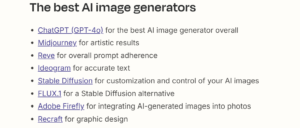If you are new to the topic of generative AI and images, a great place to start is our GenAI subject guide
You can find our full list of subject guides here
Some examples of genAI tools for image generation are:
Stable Diffusion (Open Source)
Pictory (for making videos)
There are lots of other suggestions from bloggers such as Zapier, Altexsoft, or Cnet.

Do you know about the image resources provided by the University of Edinburgh? Our high quality image databases are available to students and staff here
Resources external to the University include:
- Shutterstock
- Pixabay
- Unsplash
- Pexels
- Coolers.co (colour palette generator)
Familiarise yourself with the University of Edinburgh guidance on AI here.

ELM is the University of Edinburgh’s AI innovation platform, a central gateway providing safer access to Generative AI via access to Large Language Models (LLMs).
Access ELM here

Some things to consider:
The moral issues around AI, eg the carbon footprint of AI – the massive amounts of water and electricity that are used every single time you use it, plus the exploitation of labour from the global south in training the AI LLMs (large language models).
It is a moral issue when we know that authors and artists have had their work used to train the AI tools without their permission and with no payment or compensation or acknowledgement.
The importance of citing correctly and making it very clear in any work you do that you have used GenAI to help you plan, ideate or create.
Make sure you are very clear on what your School or department’s stance is on AI in course work or dissertations. You can find the guidance by Professor Sian Bayne here.
Use Cite Them Right to check how to reference AI in your chosen referencing style. Access Cite Them Right via DiscoverEd.

Critical thinking is even more important now, when engaging with GenAI (or deciding whether to experiment with it, or to reject it).
Learn more at the LinkedIn Learning training courses: “Generative AI Imaging: what creative Pros need to know” and “Ethics in the age of Generative AI”. Access LinkedIn Learning via MyEd.
“To say that AI on its own will be able to produce art misunderstands why we turn to the art in the first place. We crave things made by humans because we care about what humans say and feel about their experience of being a person and a body in the world.” – see The Guardian
The backlash to AI in the creative industries.
The viral reach of a social media post by sci-fi/fantasy author Joanna Maciejewska seems to demonstrate that her sentiments are widely shared:
“You know what the biggest problem with pushing all-things-AI is? Wrong direction. I want AI to do my laundry and dishes so that I can do art and writing, not for AI to do my art and writing so that I can do my laundry and dishes.”
Further reading:
“Artists should exploit AI’s capabilities, says creators of new Tate Modern show”.
GenAI threatening the jobs of creatives in film and visual media.
And remember, as David Graeber said “it doesn’t have to be this way”.
The truth about genAI is that the only thing it is about is profit.
Be critical! Ask yourself “who profits? who is exploited?”
This blogpost should not be taken as approved or endorsed by the University, and does not necessarily reflect the views of the University in respect of any particular issue. This blogpost is based on a library Bitesize training session developed by the Academic Support Librarian team, and delivered online in March 2025. For more Bitesize sessions and how to sign up, go to the events channel on MyEd.

